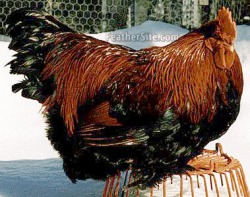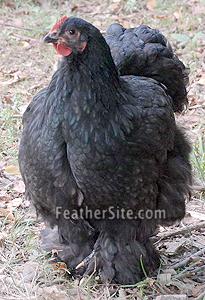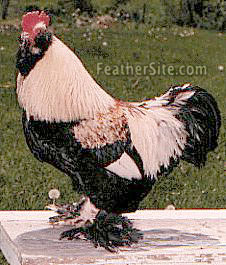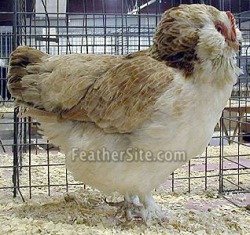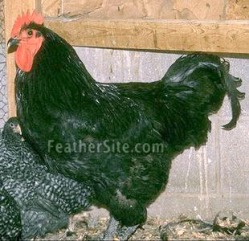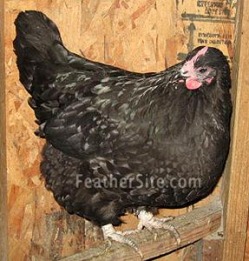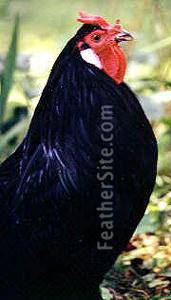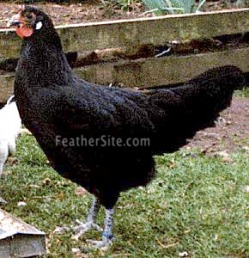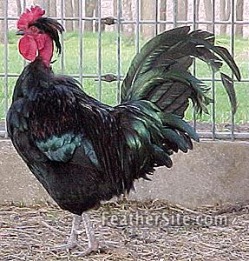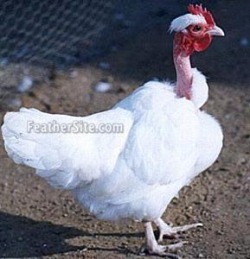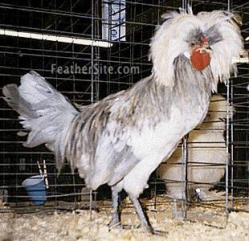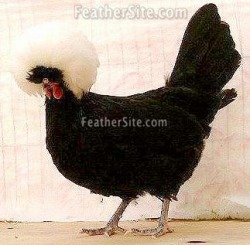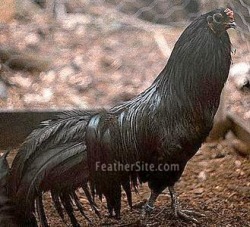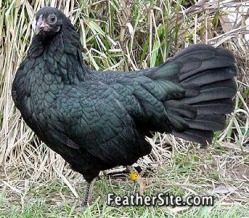T.C. Hatchery
Cochins
~Current amount: None
Cochins came to the US and England for the first time in about 1845, when they were known as Chinese Shanghai fowl. The first ones were a buff color and their size and thick soft feathering created quite a sensation, especially in England. The American Poultry Association recognizes Buff, Partridge, White, Black, Silver-laced, Golden-laced, Blue, Brown and Barred varieties.
One of the largest chickens, a full grown cock can reach 11 pounds, with the hens reaching 8 1/2 pounds. With their thick fluffy plumage, the birds look even larger. Their skin is yellow and they lay a brown egg. Although bred mostly for exhibition, they make a good meat bird. Cochins are usually very calm birds and easily made into pets. They are also excellent broodies.
One of the largest chickens, a full grown cock can reach 11 pounds, with the hens reaching 8 1/2 pounds. With their thick fluffy plumage, the birds look even larger. Their skin is yellow and they lay a brown egg. Although bred mostly for exhibition, they make a good meat bird. Cochins are usually very calm birds and easily made into pets. They are also excellent broodies.
Faverolles
~Current amount: 1 salmon cockeral
The Faverolles are a French breed, therefore of the Continental classification. Bred in the 1850s of composite blood from the Houdon, Brahma, Crêve-Cour, Dorking and common fowl of the area. Some references have been made to the CouCoo and Cochin being used in addition.
The Faverolles were used as a utility breed known for their excellent table qualities and superior egg laying during winter months. The French have a dish for which the Faverolles was used exclusively. It is called "Petite Poussin" or "Small Breast." Today they are regarded as a show fowl and are rare in the United States. They are said to be the Peacock of the poultry world for their contrasting color between the sexes and the brilliance of color in the male birds. They make excellent back yard fowl and have a genteel personality.
The overall shape of the bird should be trapezoidal and the feathering rather fluffy. Wide backs and chests are a necessity. Deep in keel with carriage well centered. Revered in the females are feathers that go backwards in the side of the hackle. The beard and muff should be extreme with little to no wattle at all. Fullness of beard is desired over length, with the beard covering the ear lobe. Face , comb, and earlobe should be red. Eye color red bay. The comb is single, and medium in size with five points and no serrations. This breed has five separate toes and skin and leg color are white. Light feathering should appear on the outside of the leg and outer toes. There is a slight break between the feathers of the body and leg. The leg feathering of the Cochin is not what is desired. Type should always be given preference over color, not only in the show pen, but in the breeding pen as well.
When considering weight on the Faverolles it is of the utmost importance to remember that the bird was originally known for its table qualities. Density and mass of the bird are what should be looked at. They are not tall birds, like Rocks, but at the same time they are not short and close to the ground. The breadth of the chest and legs is where the mass comes in. Ideal weights are suggested in the American Poultry Association Standard for our American birds. Cocks: 8 lbs. Hens: 6 1/2 lbs. Cockerels: 7 lbs. Pullets: 5 1/2 lbs. The Standards of other countries call for more or less within a pound. But, it is stated in several writings from the early 1900's that bigger usually means a cost in the quality and type of the bird.
In the Salmon variety, the hen is a completely different color from the male. This is the only breed that has this color. The male is black in beard, breast, and underneath with straw colored hackle, back, and saddle. Rich golden on the bow of the wing with a white triangle at the tip. Tail primaries beetle green and leg feather black. Underfluff should be slate gray. The hen has a color range from pink salmon to copper salmon on the hackle, back, and wing. Creamy white from the beard to the vent with no splashing of top color and an overall slate gray underfluff.
Other varieties of the Faverolles are limited to white in the United States. All of the aforementioned type descriptions would apply to this breed regardless of variety. In Europe other colors do exist and Blacks and Buff are being worked on in this country. They come in Large Fowl and Bantam form. If you have ever wanted a beautiful bird, with wonderful personality and challenge in the breeding pen, try some. They are well worth the effort and time.
The Faverolles were used as a utility breed known for their excellent table qualities and superior egg laying during winter months. The French have a dish for which the Faverolles was used exclusively. It is called "Petite Poussin" or "Small Breast." Today they are regarded as a show fowl and are rare in the United States. They are said to be the Peacock of the poultry world for their contrasting color between the sexes and the brilliance of color in the male birds. They make excellent back yard fowl and have a genteel personality.
The overall shape of the bird should be trapezoidal and the feathering rather fluffy. Wide backs and chests are a necessity. Deep in keel with carriage well centered. Revered in the females are feathers that go backwards in the side of the hackle. The beard and muff should be extreme with little to no wattle at all. Fullness of beard is desired over length, with the beard covering the ear lobe. Face , comb, and earlobe should be red. Eye color red bay. The comb is single, and medium in size with five points and no serrations. This breed has five separate toes and skin and leg color are white. Light feathering should appear on the outside of the leg and outer toes. There is a slight break between the feathers of the body and leg. The leg feathering of the Cochin is not what is desired. Type should always be given preference over color, not only in the show pen, but in the breeding pen as well.
When considering weight on the Faverolles it is of the utmost importance to remember that the bird was originally known for its table qualities. Density and mass of the bird are what should be looked at. They are not tall birds, like Rocks, but at the same time they are not short and close to the ground. The breadth of the chest and legs is where the mass comes in. Ideal weights are suggested in the American Poultry Association Standard for our American birds. Cocks: 8 lbs. Hens: 6 1/2 lbs. Cockerels: 7 lbs. Pullets: 5 1/2 lbs. The Standards of other countries call for more or less within a pound. But, it is stated in several writings from the early 1900's that bigger usually means a cost in the quality and type of the bird.
In the Salmon variety, the hen is a completely different color from the male. This is the only breed that has this color. The male is black in beard, breast, and underneath with straw colored hackle, back, and saddle. Rich golden on the bow of the wing with a white triangle at the tip. Tail primaries beetle green and leg feather black. Underfluff should be slate gray. The hen has a color range from pink salmon to copper salmon on the hackle, back, and wing. Creamy white from the beard to the vent with no splashing of top color and an overall slate gray underfluff.
Other varieties of the Faverolles are limited to white in the United States. All of the aforementioned type descriptions would apply to this breed regardless of variety. In Europe other colors do exist and Blacks and Buff are being worked on in this country. They come in Large Fowl and Bantam form. If you have ever wanted a beautiful bird, with wonderful personality and challenge in the breeding pen, try some. They are well worth the effort and time.
Jersey Giants
~Current amount: 1 black hen
Jersey Giants appear in the Standard of Perfection (USA) in two varieties: Black and White. Cocks should weigh 13 pounds and hens 10 pounds. The breed was developed in the 1880s in New Jersey. It carries Java, Brahma and Langshan blood and its skin is yellow. The breeders who created the breed were aiming at a large roasting fowl. As a meat bird in the modern world, however, it is slow-growing and therefore not commercially viable. On the other hand, few poultry sights are as impressive as a flock of Black Jersey Giants on a green lawn.
Australorps differ from Black Jersey Giants in that the legs of the Jersey Giant are black (some tending toward willow) and the underparts of the feet are yellow. In Lorps, the legs are black, shading to dark slate in adults, but the underparts of the feet are pinkish white. This works with good show stock, but hatchery stock is more variable and you can't ever be sure unless the birds grow to the size of Giants.
Australorps differ from Black Jersey Giants in that the legs of the Jersey Giant are black (some tending toward willow) and the underparts of the feet are yellow. In Lorps, the legs are black, shading to dark slate in adults, but the underparts of the feet are pinkish white. This works with good show stock, but hatchery stock is more variable and you can't ever be sure unless the birds grow to the size of Giants.
La Fleches
~Current amount: None
These birds were bred in the French province of La Sarthe as general purpose fowl, for both eggs and meat. They can be distinguished by their large white ear lobes and V-comb. They also have long wattles that hang well down the neck. Traces of a crest sometimes occur. A cock may weigh 8 to 10 pounds. The color, including that of the legs and feet, is always black. It probably carries the blood of both Crevecoeurs and Black Spanish.
La Fleche are reputed to be slow-maturing fowl. They are also known as good foragers on open range, happily traveling over large areas.
La Fleche also are found as bantams.
Here are 4 articles on La Fleche from the SPPA Bulletin.
La Fleche are reputed to be slow-maturing fowl. They are also known as good foragers on open range, happily traveling over large areas.
La Fleche also are found as bantams.
Here are 4 articles on La Fleche from the SPPA Bulletin.
Naked necks
~Current amount: 2 red chicks [a pair]
The Turken is an interesting looking beast. Either you love it or you hate it, it seems. I know both staunch defenders of the breed and people who don't even like to see them.
They got the name Turken from their appearance, which suggests that perhaps a chicken was crossed with a turkey to get this bird. This is not the case. In fact, I don't recall ever coming across a documented reference to a chicken/turkey hybrid--a bird which would definitely be sterile, and not the progenitor of a new breed.
The breed probably originated in Hungary, but the Germans perfected the type. One reason for their development is that with less feathers, they are much easier to pluck than the average table fowl. A Naked Neck has less than half the number of feathers possessed by other breeds of their size. They are good layers of brown eggs, quite hardy in cold weather, and due to their light feathering also take heat better than most breeds. They are quite popular in South Africa, where they are known under the name "Kaalnek."
The naked neck gene is dominant, so any first generation crosses with this fowl will show the naked neck, although often with a larger patch of feathers on the neck.
They got the name Turken from their appearance, which suggests that perhaps a chicken was crossed with a turkey to get this bird. This is not the case. In fact, I don't recall ever coming across a documented reference to a chicken/turkey hybrid--a bird which would definitely be sterile, and not the progenitor of a new breed.
The breed probably originated in Hungary, but the Germans perfected the type. One reason for their development is that with less feathers, they are much easier to pluck than the average table fowl. A Naked Neck has less than half the number of feathers possessed by other breeds of their size. They are good layers of brown eggs, quite hardy in cold weather, and due to their light feathering also take heat better than most breeds. They are quite popular in South Africa, where they are known under the name "Kaalnek."
The naked neck gene is dominant, so any first generation crosses with this fowl will show the naked neck, although often with a larger patch of feathers on the neck.
Polish
~Current amount: 1 silver-laced chick
Known in England as the Poland, this is the most popular of the crested breeds. It is also one of the oldest, being known as a pure breed as early as the sixteenth century. The Polish breed probably originated on the Continent, but nothing is truly known about its origins.
This ornamental, non-sitting breed lays a white-shelled egg. Its most prominent feature is the crest of feathers on the head. Note the more "umbrella-like" crest on the males and the powder-puff shape on the hens. It also has the large nostrils typical of crested breeds and a small V-comb. Many varieties occur, including White Crested Black, White, Golden, Silver, and Buff-laced. These can be either bearded or non-bearded.
Polish cocks weigh in at 6 pounds, while the hens only reach 4 1/2 pounds.
This ornamental, non-sitting breed lays a white-shelled egg. Its most prominent feature is the crest of feathers on the head. Note the more "umbrella-like" crest on the males and the powder-puff shape on the hens. It also has the large nostrils typical of crested breeds and a small V-comb. Many varieties occur, including White Crested Black, White, Golden, Silver, and Buff-laced. These can be either bearded or non-bearded.
Polish cocks weigh in at 6 pounds, while the hens only reach 4 1/2 pounds.
Sumatras
~Current amount: 2 black chicks [a pair]
Sumatras (also frequently referred to as Black Sumatras, although other colors--chiefly white and blue--are available, particularly in bantam size) are a highly decorative fowl hailing from the Indonesian island that is its namesake. They are one of the very old breeds, admitted into the American Standard of Perfection in 1883, although having been originally imported in 1847. There is a lot of speculation as to the origin of the Sumatra; some believe that this breed may have originally been another race of jungle fowl, before being interbred with other fowls, and some think it may be the result of a cross with Gallus varius, the Green Junglefowl, or even that it may be from some other pheasant cross. The Sumatra may be an ancestor or relative of the Silkie, and possibly the forebearer of muffed and tasseled OE Games; it has certainly been used a fighting fowl and as a cross for other Game breeds, although it is now exclusively an exhibition bird.
The Sumatra today is a nice layer of white or tinted eggs; if one fancies small, pheasant-type birds, it can even be used as a meat fowl, although the dark pigment might be a detracting point. What is the breed's chief strong point is its beautiful, lustrous black plumage, shining with a really intense beetle green sheen. The head has an intelligent, wild-bird appearance; a small pea comb, tiny or no wattles, a large chocolate brown eye, and facial skin the color of a ripe black plum. The legs are glossy black, and the cocks frequently have a cluster of several spurs on each leg (a breed peculiarity). Both sexes have a long tail carried low, but the male has a particularly impressive heavy sweep of long, brilliant, curving, sharply pointed tail feathers.
The Sumatra today is a nice layer of white or tinted eggs; if one fancies small, pheasant-type birds, it can even be used as a meat fowl, although the dark pigment might be a detracting point. What is the breed's chief strong point is its beautiful, lustrous black plumage, shining with a really intense beetle green sheen. The head has an intelligent, wild-bird appearance; a small pea comb, tiny or no wattles, a large chocolate brown eye, and facial skin the color of a ripe black plum. The legs are glossy black, and the cocks frequently have a cluster of several spurs on each leg (a breed peculiarity). Both sexes have a long tail carried low, but the male has a particularly impressive heavy sweep of long, brilliant, curving, sharply pointed tail feathers.
All bird info is from http://www.feathersite.com
